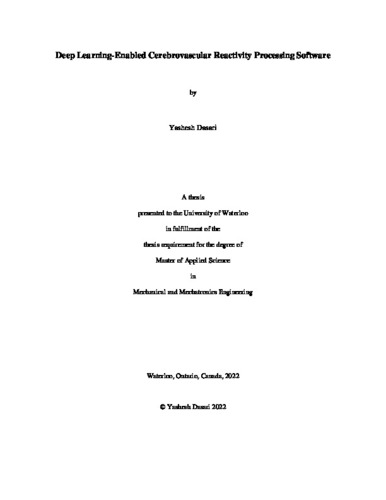UWSpace will be migrating to a new version of its software from July 29th to August 1st. UWSpace will be offline for all UW community members during this time.
Deep Learning-Enabled Cerebrovascular Reactivity Processing Software
| dc.contributor.author | Dasari, Yashesh | |
| dc.date.accessioned | 2022-12-23 14:56:32 (GMT) | |
| dc.date.available | 2022-12-23 14:56:32 (GMT) | |
| dc.date.issued | 2022-12-23 | |
| dc.date.submitted | 2022-12-19 | |
| dc.identifier.uri | http://hdl.handle.net/10012/19002 | |
| dc.description.abstract | Magnetic Resonance Imaging (MRI) is a non-invasive medical imaging technique that is used to generate high-resolution images of the brain. Blood oxygenation level dependent (BOLD) imaging is a functional MRI technique that maps the differences in cerebral blood flow (CBF). Cerebrovascular Reactivity (CVR) is a provocative test used with BOLD-MRI studies where a vasoactive stimulus is applied and the corresponding changes in the CBF differences are analyzed. This test is analogous to a cardiac stress test where the patient exercises and the change in heart blood flow are observed. CVR is measured as the ratio of the change in BOLD signals to the change in the vasoactive stimulus. The vasoactive stimulus used in this work is the arterial partial pressure of carbon dioxide. The gas control for applying the stimulus is accomplished using a computer-controlled device called RespirAct RA-MRTM. CVR studies can highlight abnormalities in the brain vasculature and therefore, indicate underlying pathological conditions. Studies have demonstrated a close correlation between an irregular CVR distribution and cerebrovascular diseases like Alzheimer’s disease, steno-occlusive disease (SOD), stroke, and traumatic brain injury. SOD is the most common cause of ischemic stroke all over the world. Patients with symptomatic SOD are at a high risk of recurrent ischemic stroke. Therefore, information about the severity and spatial location of irregular CVR at the brain tissue level can help guide clinical treatment. The current generation of CVR analyses and assessments are conducted manually by a team of doctors and radiologists, using their subject expertise and years of experience. In this work, a next-generation CVR processing and visualization software application is presented that furthers the research capabilities of CVR analyses. The proposed software is capable of processing raw BOLD-MRI files and generating CVR maps. It is developed using open-source tools and deployed as a stand-alone application that runs on a virtual machine. Additionally, convolutional neural networks (CNNs) are designed to facilitate the screening of SOD patients by classifying the CVR maps into healthy and unhealthy patients. Some popular pre-trained networks, like, EfficientNetB0, InceptionV3, ResNet50, and VGG16 are fine-tuned to accomplish the target classification. For training the CNNs, the original dataset consisted of 68 healthy and 163 unhealthy images. To increase the number of trainable samples and address the data imbalance, image augmentation techniques were applied. An empirical evaluation-based design strategy is implemented for optimizing the network architecture. The performance of different CNN architectures along with fine-tuning of hyperparameters was analyzed and the most optimal network is presented. Results from transfer learning are compared as well. Experiments indicated that a customized CNN with two convolution layers with 32 filters and a hidden fully connected layer with 32 neurons produced the best results. This model used batch normalizations and dropout regularization after the convolution layers and the fully connected layer. It achieves high training/validation/prediction results consistent with expert clinical readings. The proposed software integrates the complete CVR research workflow, including file management, processing MRI files, data visualization, and producing CVR maps, and serves as a clinical decision support system, automating the workflow by 75% and providing a one-stop software solution. It is suggested that this software is used as a research tool to produce CVR maps and make data-driven decisions on SOD screenings, along with validation by experts. | en |
| dc.language.iso | en | en |
| dc.publisher | University of Waterloo | en |
| dc.subject | artificial intelligence | en |
| dc.subject | cerebrovascular reactivity | en |
| dc.subject | convolutional neural network | en |
| dc.subject | deep learning | en |
| dc.subject | magnetic resonance imaging | en |
| dc.subject | software development | en |
| dc.subject | steno-occlusive disease | en |
| dc.title | Deep Learning-Enabled Cerebrovascular Reactivity Processing Software | en |
| dc.type | Master Thesis | en |
| dc.pending | false | |
| uws-etd.degree.department | Mechanical and Mechatronics Engineering | en |
| uws-etd.degree.discipline | Mechanical Engineering | en |
| uws-etd.degree.grantor | University of Waterloo | en |
| uws-etd.degree | Master of Applied Science | en |
| uws-etd.embargo.terms | 0 | en |
| uws.contributor.advisor | Khamesee, Behrad | |
| uws.contributor.affiliation1 | Faculty of Engineering | en |
| uws.published.city | Waterloo | en |
| uws.published.country | Canada | en |
| uws.published.province | Ontario | en |
| uws.typeOfResource | Text | en |
| uws.peerReviewStatus | Unreviewed | en |
| uws.scholarLevel | Graduate | en |

